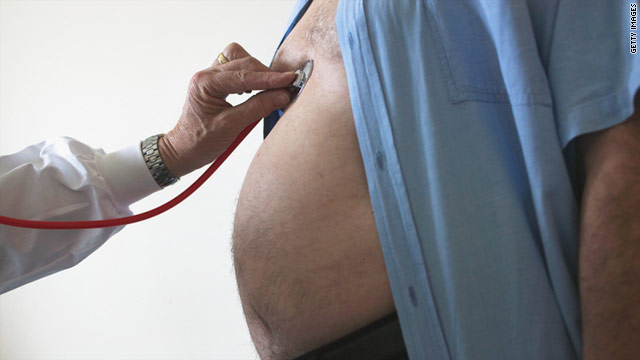
(Health.com) -- Ann Silk, MD, worries about her overweight patients. But Dr. Silk, an internal-medicine resident at the University of Pittsburgh Medical Center, isn't concerned only about their diets and cholesterol levels.
She also worries that the fatty tissue on their bodies will obscure other health problems, like tumors.
Although excess weight is hard on a patient's body, it's also hard on doctors who are trying to perform physical exams.
Blood pressure cuffs have to be bigger. Stethoscopes can't pick up subtle heart abnormalities and lung sounds muffled by flesh. And medical scales often max out at 350 pounds -- making it hard to determine exactly how overweight the largest patients are.
Moreover, excess body fat can interfere with a doctor's ability to assess thyroid or liver health or recognize abnormal growths.
Even with all the high-tech medical tools at their disposal, doctors still find out some important, potentially life-saving information by touching and feeling their patients' bodies. Fat makes that job much tougher.
Health.com: Slim down at any age
"It's a worry that we're not finding what we need to find on exams because there is tissue in the way of our fingers, and in the way of our stethoscope," says Dr. Silk, who co-authored an article about this problem in this week's issue of the Journal of the American Medical Association.
"It leaves us with a little bit of uncertainty -- maybe you would even say insecurity -- whether we are identifying all the abnormalities on [an] exam."
In some cases, this uncertainty could lead to missed tumors or other oversights, Dr. Silk adds. "For the abdominal and gynecological exam, a mass would have to be pretty big before you could find it."
John Simmons, MD, an assistant professor of family and community medicine at the Texas A&M Health Science Center, in College Station, says that doctors can't identify conditions such as liver problems, hernias, and fluid buildup in the abdomen through physical exams alone.
Still, he says, abdominal, breast, thyroid, and genital examinations are particularly difficult in obese patients.
Health.com: 19 new reasons to keep fat off
For this reason, obese patients should be especially proactive about making sure they get regular screening tests, Dr. Simmons says. If necessary, they should "take it upon [themselves] to remind the doctor of potentially embarrassing but critically important screening tests like mammograms, Pap smears, genital exams, and colonoscopies."
The impact of obesity on physical examinations is still a new area of research, Dr. Silk says. To her knowledge, no studies have been conducted on whether excess body fat can delay serious diagnoses, and medical schools and textbooks appear to be lagging behind the rise in obesity rates.
More than one in three U.S. adults are obese, and two out of every three are overweight. The average American man and woman now weighs 195 pounds and 165 pounds, respectively -- about 18% more than they did in 1960.
Health.com: Best and worst advice from top diet plans
Dr. Silk and her co-author argue that the standard physical exam needs to be modified as a result. Here are some of the changes they say doctors and obese patients should consider during their next physical:
Longer breast exams. Some data suggests that a good breast exam takes three minutes per breast, but even longer in a heavier patient, Dr. Silk says. Doctors and patients should be prepared to spend some extra time on breast exams.
Rest before tests. Obese patients may grow short of breath after walking even brief distances, which could throw off readings for heart rate, blood pressure, and breathing rate. If needed, doctors should encourage obese patients to sit quietly for 15 minutes before checking their vital signs.
More elbow grease. Belly fat can make it harder for doctors to feel for liver problems or unhealthy fluid buildup in the abdomen, which means doctors may need to press extra firmly or spend more time on this area. "Patients have to be good sports at tolerating vigorous exams," Dr. Silk says.
Different instruments. Standard medical instruments may not be sufficient to examine heavier people. For instance, doctors may need to use a handheld imaging device known as a Doppler (rather than a stethoscope) to measure heart rate in obese patients, and they may need to use a longer speculum for gynecological exams.
Health.com: 13 oversize products for overweight people
These changes aren't likely to address all the shortcomings of the physical exam, however. Medical training and textbooks will eventually need to be updated to reflect the obesity epidemic, Dr. Silk and her colleague write, and some doctors may need to invest in new technology and equipment.
Copyright Health Magazine 2010
No comments:
Post a Comment
Note: Only a member of this blog may post a comment.